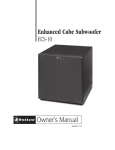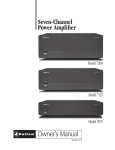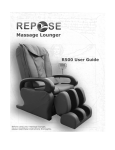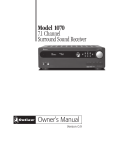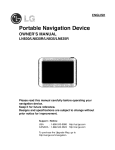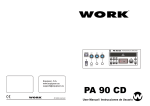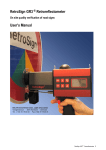Download Outlaw Audio LFM-1EX User's Manual
Transcript
Variable Tuning LFM Series Low Frequency Modules LFM-1 EX and LFM-1 Plus Owner’s Manual Version 1.0 Owner’s Manual Please Read First Please Read First CAUTION: To reduce the risk of electric shock, do not remove the cover (or back). No user serviceable parts inside. Refer to qualified personnel. WARNING: To reduce the risk of fire or electric shock, do not expose this appliance to rain or moisture. The lightning flash with arrowhead, within an equilateral triangle, is intended to alert the user to the presence of uninsulated “dangerous voltage” within the product’s enclosure that may be of sufficient magnitude to constitute a risk of electrical shock to persons. The exclamation point within an equilateral triangle is intended to alert the user to the presence of important operating maintenance (servicing) instructions in the literature accompanying the appliance. Precautions Verify The Line Voltage Your new Low Frequency Module has been factory configured for 120 volt AC lines. Connecting the LFM-1 EX or LFM-1 Plus to a line voltage other than that for which it is intended can create a safety and fire hazard, and may damage the subwoofer. If you have any questions about the voltage requirements for your specific model, or about the line voltage in your area, contact Outlaw Audio before plugging the unit into a wall outlet. Verify AC Circuit Capacity The high power output of your Outlaw LFM may require heavy power draw under full load conditions. To insure proper performance, and to avoid potential safety hazards, we recommend that it be connected to a 20 Amp capacity circuit. Connecting multiple subwoofers to the same circuit, or connecting it to a circuit used by other heavy power devices, such as air conditioners, may cause circuit breakers to trip. Do Not Open The Cabinet There are no user serviceable components inside this product. Opening the cabinet may present a shock hazard, and any modification to the product will void your guarantee. If water or any metal object, such as a paper clip, coin or a staple, accidentally falls inside the unit, disconnect it from the AC power source immediately, and contact Outlaw Audio for further instructions. FCC Information for User CAUTION: ANY changes or modifications not expressly approved by the party responsible for compliance could void the user’s authority to operate the equipment. NOTE: This equipment has been tested and found to comply with the limits for a Class B digital device, pursuant to Part 15 of the FCC Rules. These limits are designed to provide reasonable protection against harmful interference in a residential installation. This equipment generates, uses and can radiate radio frequency energy and, if not installed and used in accordance with the instructions, may cause harmful interference to radio communications. However, there is no guarantee that interference will not occur in a particular installation. If this equipment does cause harmful interference to radio or television reception, which can be determined by turning the equipment off and on, the user is encouraged to try to correct the interference by one or more of the following measures: • Reorient or relocate the receiving antenna. • Increase the separation between the equipment and receiver. • Connect the equipment into an outlet on a circuit different from that to which the receiver is connected. IMPORTANT SAFETY NOTE Before connecting a new component such as the LFM to your audio or home theater system it is always good practice to make certain that all components are turned off, and preferably unplugged from their AC power source. Many modern electronics products feature automatic turn-on circuits that may be activated during an installation, causing the potential for damage to electronic components and/or speakers. Such damage is not covered by product warranties and Outlaw Audio specifically disclaims responsibility for any such damage. NOTE: It is always a good idea to avoid using any audio or video equipment on the same AC circuit as equipment with motors, such as air conditioners or refrigerators. This will lessen the possibility of power variation and electrical start-up noise affecting your sound system. Extension Cords and Power Strips We do not recommend that extension cords be used with this product unless they are of sufficient gauge to pass the necessary current during full load conditions. Most inexpensive extension cords are not capable of such high-current loads. Similarly, should you use a power strip, surge protector or any type of AC power line conditioning equipment, make certain that it is also able to handle the high current loads this product will produce. Handle the AC Power Cord Gently When disconnecting the power cord from an AC outlet, always pull the plug, never pull the cord. If you do not intend to use the amplifier for any considerable length of time, disconnect the plug from the AC outlet. If the power cord is replaced, make certain that it is of similar gauge. As with all electrical devices, do not run power cords under rugs or carpets or place heavy objects on them. Damaged power cords should be replaced immediately with cords meeting factory specifications. Wiring Cables that are run inside of walls should have the appropriate markings to indicate complaince with, and listing by the UL , CSA or other standards required by the UL, CSA, NEC or your local building. Questions about cables inside of walls should be referred to a qualified customer installer, or a licensed electrician or low-voltage contractor. Outlaw Audio For Future Reference Record your Model LFM serial number and date of purchase here. It is found on the back panel. Model Number Serial Number Date of Purchase Owner’s Manual Variable Tuning LFM Series Low Frequency Module Table of Contents 2 3 3 3 3 4 4 4 5 5 5 7 7 7 7 7 7 8 8 8 8 8 8 9 9 9 9 9 9 10 10 11 11 Please Read First Table of Contents Variable Tuning LFM Series Low Frequency Modules Unpacking Accessories Before You Begin Installing Subwoofer Feet Variable Tuning LFM Controls and Connections Subwoofers, Bass and Overall System Performance Setup Guide Connecting to Your System Connecting to a System with a Subwoofer Preamp Output Connecting to a System with no Preamp Outputs Subwoofer Placement Notes On Subwoofer Placement Setting the Variable Tuning LFM Series Subwoofer's Controls Variable Crossover Phase Switch Port Switch Volume Level S2: The Scattered Subwoofer System What’s Needed to Connect Two Subwoofers? Placement and Level Control Care and Maintenance Cleaning When You Are Away Troubleshooting Outlaw Service Information Troubleshooting Guide Model LFM-1 EX Specifications Model LFM-1 Plus Specifications The Outlaw Audio 30-Day Satisfaction Guarantee Outlaw Audio Limited Warranty Variable Tuning LFM Series Low Frequency Modules Congratulations on the purchase of an Outlaw Audio Variable Tuning LFM (Low Frequency Module). You now own one of the finest subwoofers available. The Variable Tuning LFM series subwoofers provide deep, tight, bass extension that’s powerful enough to meet the most demanding requirements of any movie or musical source. The LFM series subwoofers blend effortlessly with both small satellite speakers and large tower speakers alike. This seamless integration is made possible by a flexible crossover network that may also be disengaged for use with advanced bass-management systems. Among the Variable Tuning LFM’s many features are: A down firing design that virtually eliminates audible port noise ■ A long throw 12" driver for deep bass extension ■ A powerful 325 watt BASH¨ amplifier for precise driver control ■ Signal Sense for automatic turn on/off ■ 180-degree phase control ■ Line and speaker level inputs ■ ■ Variable Port Tuning Detachable power cord ■ Unpacking The carton and packing materials used in shipping your new subwoofer were specially designed to cushion it from the shocks and vibrations of shipping. We strongly suggest that you save the carton and packing materials to use if you move, or if the unit ever needs to be shipped back to us for any reason. To minimize the size of the carton in storage, you may wish to flatten it by carefully opening the top and bottom flaps and folding the carton. Packing materials that cannot be collapsed should be saved along with the carton in a plastic bag. Accessories After unpacking your Variable Tuning LFM series subwoofer please confirm that the following accessories have been included. AC Power Cord ■ 4 Black (Metal) Carpet Spikes ■ 4 Black (Meta)l Dimpled Discs ■ ■ Port Plug (Installed In port on bottom of subwoofer) This Owner’s Manual ■ The contents of this manual are Copyright © 2007 by Outlaw Audio, LLC, and may not be duplicated or reproduced by any means, whether physical, electronic or otherwise without prior written consent from Outlaw Audio. If any of the above is missing from your shipment, please contact Outlaw Audio immediately. Outlaw Audio and the Outlaw Audio logo are registered trademarks of Outlaw Audio, LLC. Specifications are those in effect at the time of printing. Outlaw Audio reserves the right to change specifications or designs at any time without notice or obligation to modify existing units. Variable Tuning LFM Series Low Frequency Modules Owner’s Manual Before You Begin Before You Begin Before proceeding with the integration of the LFM into your system, please observe the following precautions and suggestions. ■ ■ ■ ■ ■ ■ Do not plug the power cord into the LFM until all other connections are made. Rear Panel (LFM-1 EX shown) A B C D E F G H K L M Always refer to the instructions that came with your receiver or processor for specific procedures, warnings and options. Do not attempt to operate the LFM unless the feet have been properly installed. This may restrict driver movement and will cause damage to your LFM that is not covered by the warranty. When using the subwoofer on surfaces such as wood floors and certain tight weave rugs, be sure to use the supplied dimpled discs to prevent damage to floor's surface. You are responsible for determining when use of these discs is required. Make sure to insert all plugs and connectors securely. Improper connections can result in noise, poor performance, or damage to the equipment. Do not bundle the subwoofer cable or speaker wire with the power cord. This may adversely affect the sound quality and introduce unwanted hum into your system. Installing Subwoofer Feet Proper installation of the supplied feet/carpet spikes is necessary for ALL LFM subwoofer setups. These spikes provide the ground clearance that is required for optimal performance and safety. Failure to use the feet provided will result in damage not covered under the Outlaw Audio Warranty. For your convenience we have provided “dimpled discs” that may be used when the LFM is placed on surfaces other than carpet, such as wood, tile, certain rugs and linoleum surfaces to prevent damage to the floor or floor covering. To install the spikes, follow these steps: I J 1. Carefully turn the subwoofer upside down. 2. Screw a foot/carpet spike into the threaded hole in each corner of the LFM subwoofer. Tighten the spike by hand until no threads are showing and the base of the foot is flush with the bottom of the cabinet. NOTE: If the LFM is being placed on a surface that may be damaged by the carpet spikes, place one of the black, dimpled discs that is supplied with the LFM subwoofer on the floor surface in each corner of the location where the LFM will be placed. 3. After all four carpet spikes have been installed, turn the LFM over so that it is upright. We recommend that this be done by two people due to the weight of the unit, and to make certain that the floor surface is not damaged while the unit is being turned back to the upright positions. Outlaw Audio LFM Controls and Connections A AUTO Power Switch Enables the LFM’s signal sense mode so that the unit turns on automatically when an audio signal is present. G X-OVER Switch When an external crossover such as the Outlaw Audio ICBM is used, use this switch to bypass the LFM’s internal crossover. E CROSSOVER FREQUENCY Control Sets the frequency of the built in variable low pass crossover. H Port Switch Toggles the LFM between “Max Output” and “Bass Extension” mode. B PHASE Switch Switches the phase of the LFM subwoofer with respect to the main speakers. C VOLUME Control Use this knob to control the output level of the LFM. Owner’s Manual Setup Guide F SUB IN Jack Connect the subwoofer output of your receiver, processor or other source device or accessory to this jack. I HIGH LEVEL Inputs When your receiver does not have line level outputs available for a subwoofer connection, connect the speaker outputs of the receiver here. D POWER INDICATOR Light This indicator is green when the LFM is on and red when power is applied, but the unit is in the standby mode. J HIGH LEVEL Outputs When the speaker level inputs are used, connect the main speakers to these terminals. K Power Cord Jack Connect the supplied AC power cord here, and then connect the plug end to an un-switched AC wall output. Should the power cord need replacement, make certain it is replaced with a cord having the identical power rating. L Fuse Housing Contains a 20mm 3.15A slow blow fuse that protects the subwoofer. In the event that it must be replaced, be certain that a fuse with the same rating is used. M MASTER POWER Switch Use this switch to turn the LFM subwoofer on or off. When the unit will not be used for extended periods, we recommend turning this switch off to prevent accidental activation. Subwoofers, Bass and Overall System Performance The goal of an audio system is to recreate the source material as accurately as possible. The components needed to perform this task are an audio source, a receiver or processor/amplifier combination, and speakers. In the era of digital, multi-channel sound, many listeners have chosen to use frequency-limited “satellite” speakers for the front, center and surround channels. By limiting their frequency range, these speakers may be made smaller, to more easily fit into a wide range of spaces. However, by eliminating the capability to reproduce bass frequencies, a separate speaker that is custom designed to deal with signals below 200Hz is required. That speaker, along with its companion, built-in amplifier is a powered subwoofer. Even in two-channel systems with traditional bookshelf or tower speakers the bottom two octaves of sound (20 Hz to 80 Hz) are frequently rolled off or not reproduced at all. Here, too, a specialized speaker/amplifier combination is required to deliver the full spectrum of sound from a system. Setup Guide Connecting to Your System To get the maximum performance from your new LFM subwoofer it must be connected and, positioned properly within the room and configured to match your speakers. To connect an LFM Series Subwoofer you will need either a single audio interconnect cable (in the case of systems with a subwoofer output) or additional speaker wire. We recommend the Outlaw Audio PCA SUB cable, but any high quality, shielded audio interconnect will work properly. Connecting to a System with a Subwoofer Preamp Output If a low-level subwoofer output is available, use this jack to connect your LFM subwoofer to your Preamp or Receiver. See Diagram 1 on page 6. To connect the LFM to a subwoofer preamp output: 1. Turn off all system components and unplug the processor or receiver and the LFM from their AC power source. 2. Locate the “Subwoofer/LFE Output” on the rear panel of your receiver or processor. Any audio product that decodes Dolby Digital or DTS soundtracks will have this type of jack. Depending on the particular brand or model, this RCA jack may be labeled “Sub,” “Subwoofer,” or “LFE Out.” If your receiver or processor does not have this type of output you will need to follow the “Connecting to a System with No Preamp Outputs” instructions that follow this section. 3. Connect one end of the subwoofer cable to the subwoofer or LFE output on the receiver or processor. 4. Locate the connection labeled SUB IN on the rear panel of the subwoofer and connect the other end of the subwoofer cable to that jack. 5. Plug the LFM’s power cord into the input on the LFM Series Subwoofer and connect the plug to an un-switched AC outlet. CAUTION: Due to the power requirements of the LFM, it must not be connected to the accessory outlets on a receiver or processor. If a power-strip or surge protector is used, make certain that it is rated to accommodate your LFM’s power requirements. 6. Reconnect your processor or receiver to the AC power source. 7. Proceed to the “Setting The LFM’s Controls” section to learn about the LFM’s controls and how they operate. Finally, many multi-channel digital soundtracks contain a special audio channel devoted specifically to extreme low frequency extension. This signal is the “.1” in 5.1, 6.1 and 7.1 systems and is sometimes referred to as the LFE channel. Regardless of which of these situations create the need, a subwoofer is absolutely essential for accurate audio reproduction of both movies and music. A properly designed subwoofer such as an Outlaw LFM Series Sub can provide a visceral impact that most speakers are not able to provide on their own. No matter what type of speakers comprise the rest of your system, or what your favorite movie or music is, the LFM series subwoofers complete the sonic presentation by providing the impact that only a subwoofer can deliver. Variable Tuning LFM Series Low Frequency Modules Owner’s Manual Wiring Diagrams Diagram 1: Connecting to a System with a Subwoofer Preamp Output Y PB PR Y PB PR Y PB PR DVD VIDEO 1 DIGITAL OUTPUT MONITOR OUT AM/FM ANTENNA CD MADE IN MALAYSIA OPT 2 E FM757 FRONT S VIDEO DC TRIGGER EXT REMOTE MAIN ZONE MAIN ZONE OUT – TAPE – IN SERIAL No. OPT 1 COMPONENT VIDEO AM AUX 1 AUX 2 DVD VIDEO 1 VIDEO 2 VIDEO 3 OUT – VCR – IN L L CEN R R SUB ANALOG BASS MANAGEMENT OUT OPT 3 ON DVD VIDEO 1 VIDEO 2 VIDEO 3 OUT – VCR – IN OUT OPT 4 MULTI CHANNEL INPUT L R ZONE OUT Preamp/Processor RISK OF ELECTRIC SHOCK DO NOT OPEN Manufactured under license from Digital Theater Systems, Inc. US Pat. No. 5,451,042 and other world-wide patents issued and pending. “DTS”, “DTS Digital Surround”, are trademarks of Digital Theater Systems, Inc. Copyright 1996 Digital Theater Systems, Inc. All Rights Reserved. AVIS RISQUE DE CHOC ELECTRIQUE/NE PAS OUVRIR Manufactured under licensce from Dolby Laboratories “Dolby”, “Pro Logic”, “Dolby Digital” and the double-D symbol are trademarks of Dolby Laboratories, Confidential Unpublished Works. © 1992-1997 Dolby Laboratories, Inc. All rights reserved. OUTPUT L L L CEN COAX 1 R R R SUB COAX 2 FRONT Model 950 WARNING SURR SURR ON OFF SURR BACK DIGITAL INPUT THIS DEVICE COMPLIES WITH PART 15 OF THE FCC RULES. AC 120V 60Hz POWER CONSUMPTION POWER OUTPUT CEN SUB SURR BACK DIGITAL INPUT LFM INPUT SURROUND RIGHT SURROUND LEFT FRONT RIGHT OUTPUT OUTPUT OUTPUT + - + - CAUTION INPUT RISK OF ELECTRIC SHOCK DO NOT OPEN INPUT AVIS: RISQUE DE CHOC ELECTRIQUE/NE PAS OUVRIR Diagram 2: Connecting to a System with No Preamp Outputs INPUT INPUT CENTER FRONT LEFT OUTPUT OUTPUT ON + + - HAZARDOUS ENERGY. MAKE PROPER SPEAKER CONNECTIONS: SEE OWNER'S MANUAL BEFORE USING. Outlaw Audio LFM Receiver or Amplifier - WARNING: Right Speaker OFF MASTER SWITCH CIRCUIT BREAKER 15 AMP + - REMOTE TRIGGER (POWER ON/OFF) 12V DC 120 VAC/60Hz 1800W Left Speaker Owner’s Manual Setting the Variable Tuning LFM Series Subwoofer’s Controls Connecting to a System with No Preamp Outputs If no low-level subwoofer output is available, you will need to run speaker wires from your main amplifier or receiver to the subwoofer amplifier. See Diagram 2 on page 6. To connect a Variable Tuning LFM Series Subwoofer using high level inputs: 1. Turn off all system components and unplug the receiver and/or amplifier and the LFM from their AC power source. 2. Locate the front left/right speaker output terminals on your receiver or amplifier. In cases where there are both “A” and “B” terminals, the “A” terminals should be used. Disconnect any wire that is presently connected to these terminals. 3. Using the same type of speaker wire used for your other speaker connections, connect the left and right channel speaker outputs of your receiver or amplifier to the LFM’s High Level Inputs. Be sure to connect the speaker wires to the appropriate input binding posts on the back of the LFM, making certain that the polarity (–/+) on the receiver or amplifier matches the polarity on the binding posts of the subwoofer amp. In most cases this means connecting the red terminal on the receiver or amplifier to the red terminal on the LFM, but always check the markings on the rear panel to insure “+ to +” and “– to –” connections. Also, make sure that the negative outputs on your main amp are true ground; otherwise you would short the output of your main amp. Call or email tech support if the negative outputs on your main amplifier do not have true ground. 4. Connect the speaker wires to the high-level output terminals on the back of the LFM Series Subwoofer. Make certain that the polarity (–/+) on the subwoofer's high-level output terminals match the polarity on the binding posts of the speakers. Also, be sure to prevent any positive and negative strands of speaker wire from crossing. 5. Plug the LFM’s power cord into the input on the LFM Series Subwoofer and connect the plug to an un-switched AC outlet. CAUTION: Due to the power requirements of the LFM Series Subwoofers, they must not be connected to the accessory outlets on a receiver or processor. If a power-strip or surge protector is used, make certain that it is rated to accommodate the LFM’s power requirements. 6. Reconnect your receiver and/or amplifier to the AC power source. 7. Proceed to the “Setting The LFM’s Controls” section to learn about the LFM’s controls and how they operate. Subwoofer Placement Placement of your LFM series subwoofer is a critical component in maximizing its performance. The subwoofer's specific location in a room influences its “perceived” frequency response, sound pressure level (SPL), and overall accuracy. Since each listening room differs in virtually every aspect, the ideal location will also vary. An easy way to find the right spot to place your new Variable Tuning LFM Series Subwoofer is to experiment with what we call the “Subwoofer Switch Trick.” This process puts the subwoofer where you normally sit and then lets you play the role of the subwoofer. First, place the subwoofer as close to your favorite listening position as possible. This should be directly in front of your couch or easy chair, right in the room’s “sweet spot.” Provided that there is no damage to your furniture, you may even place the subwoofer on the chair or couch, but remember that LFM Series Subwoofers are heavy, and the Outlaws are not responsible for any damage to your furniture or for arguments this might cause with other members of the household! Second, activate the test tone from your processor or receiver’s internal test tone generator, or use your favorite test disc so that pink noise plays through the subwoofer. While the test tone is playing, walk around your room and find the spots where you hear the best bass response. Sometimes this may be in the center of the room, while in other cases you may find the best spot in a corner or along a sidewall. Finally, turn off the test tone and move the subwoofer to the location where you hear the best bass response. If that location is unacceptable or impractical, repeat the procedure to the spot that is the best compromise between bass performance and aesthetic considerations. Notes On Subwoofer Placement Try to avoid creating a listening position that falls directly between the front and back walls. This may cause a strong interference effect due to the collision between bass waves bouncing off the rear wall and new waves emanating from the LFM. When this happens you might hear an unnatural “build up” in the low frequencies where the bass sounds “bloated”, based on the specific dimensions of the room and the particular frequency being reproduced. In other situations you might encounter a “null”, which is caused by two low frequency waves canceling each other out. When this happens you will find that your favorite listening position is bass shy. In this type of placement situation, bass response will suffer greatly regardless of how powerful the subwoofer is. The best way to solve this problem is to change the location of the seating position so that the distance to the front of the room is different than that to the back of the room. Setting the Variable Tuning LFM Series Subwoofer's Controls Variable Crossover By adjusting the variable crossover on the LFM, you can perfectly match your LFM Series Subwoofer to your main speakers. If your receiver or processor already has a built in crossover, disable the crossover on the LFM by flipping the “X-OVER” switch to the “BYPASS” position. Refer to the owner’s manual for your receiver or processor to see how to disable any internal crossover capability it may have. If your receiver or processor does not have internal crossover control, follow these steps to set LFM’s variable crossover: Determine the +/- 3dB point of your main speakers. This frequency is usually found on the speaker’s specifications sheet or may often be available on the speaker manufacturer’s web site. Start with the crossover set approximately to this point. By experimenting with the crossover frequency and level control, you can fine-tune the LFM Series Subwoofer so that there is a seamless link between the LFM and the main speakers. Variable Tuning LFM Series Low Frequency Modules Owner’s Manual S2: The Scattered Subwoofer System If the actual +/- 3dB point cannot be obtained from the speakers’ specifications or the manufacturer’s web site, you can use the following chart as a guideline: S2: The Scattered Subwoofer System (Two LFM’s) 40 Hz Why Two Subwoofers? Large tower speaker with one 12 or 15-inch woofer or two 10-inch woofers; Small tower speaker with one 10-inch woofer or two 8-inch woofers 60 Hz Small tower or large bookshelf speaker with one 8-inch or two 6-inch woofers: 80 Hz Bookshelf speaker with one 6-inch or two 5-inch woofers 100 Hz Bookshelf speaker with one 5-inch woofer or two 4-inch woofers 120 Hz Satellite speaker with one 4-inch woofer or one or two 3.5-inch woofer(s) Phase Switch Depending on the absolute phase of your main speakers and amplifier, as well as the relative distance from the LFM Subwoofer and main speakers to the listening position, the bass in the crossover region may be smoother if you reverse the phase of the LFM. Try both positions of the phase switch to determine which way sounds more bass-heavy. The bass-heavier position is the setting where the output of the LFM and the main speakers are most in phase. Use program materials with bass in the crossover region such as music containing bass drums, double basses, bass guitar, etc., to determine the correct setting. Port Switch Depending on your bass preference, your Variable Tuning LFM Series subwoofer has two separate "tuning" modes. In Its “Max Output” mode your LFM series subwoofer will provide the greatest level of overall bass in regards to SPL (sound pressure level). In Its "Bass Extension" mode your LFM series subwoofer will provide the deepest bass (low frequency) levels. When using the Bass Extension mode you will need to ensure that the provided “port plug” Is blocking one of the ports located on the bottom of the subwoofer. In the Max Output mode, both ports should remain unplugged. CAUTION: Do not leave both ports open when the Port Switch Is In the “Bass Extension” position as your subwoofer's performance will be comprised. If one of the ports is blocked using the supplied port plug, the Port Switch must remain In the “Max Output” mode. Failure to adhere to these requirements can lead to poor performance and damage to your subwoofer. Volume Level Using the built-in test tones of your receiver/processor, match the levels of all of your speakers including your LFM Series Subwoofer as described in your receiver or processor’s owner’s manual. A setting of 5 on the LFM’s volume knob should provide enough gain to properly match the sub level to your speakers. We recommend using an SPL meter such as the Radio Shack model (part number 33-2050). When using the test tones, measure from the listening chair and set the meter to the 75 dB level. In order to accurately measure levels between channels use “C” weighting and the “slow” setting. Note that the Radio Shack meter is down about 12 dB at 16 Hz, 7 dB at 20 Hz, and 4 dB at 25 Hz. Add these numbers to the readout to compensate for these errors if necessary. Outlaw Audio In most circumstances two subwoofers will perform better than one. While you might assume this is for added SPL, the greatest benefit will actually be smoother bass response. Room shape, the cubic volume of the room (width x depth x height), furniture, floor coverings and even wall and ceiling material all play a roll in bass performance. These factors create peaks and dips in the level of low frequencies at different points in the room. That said, two properly positioned subwoofers will distribute the bass throughout the room with greater accuracy than a single sub. For this reason many professional acousticians and installers recommend more than one subwoofer. The final result is that you will create a much larger “sweet spot” where the bass is powerful but more importantly smooth and consistent. If near perfect bass response is your goal, consider using two LFM Series Subwoofers: The Outlaw Audio Scattered Subwoofer Systems. What’s Needed to Connect Two Subwoofers? Most of today’s digital receivers and preamp/processors provide a single subwoofer output. Connecting two subwoofers to these systems is as simple as adding a Yadapter. A Y-adapter splits a single output into two separate outputs. Be sure to use a Y-adapter that is of equal or better quality than the subwoofer cables you intend to use. (We recommend the Outlaw Audio PCA Y-Adapter.) To use the Y-adapter, insert the single male end of the cable to the subwoofer output of your receiver or processor. On the opposite end of the Y-adapter you will now have two separate subwoofer outputs, one for each sub. Placement and Level Control Placement and level control of two subwoofers is somewhat more complicated than using a single subwoofer. However, the end result of two properly placed and calibrated subwoofers is well worth the added effort. The procedure for placement of the second subwoofer is identical to that of determining the placement of the first subwoofer (see the “Subwoofer Placement” section of this manual). However, the second sub should be placed in the seating area outside of the “sweet spot” where good bass response is also required. Walk around the room until you find the area where the bass sounds the best, just as described in the process for locating a single sub. This spot will almost always be different than the one that was best for the primary sub. NOTE: When calibrating your second subwoofer be sure to turn off the first sub. This will help you to determine ideal placement without being mislead by the response of the first sub. When calibrating the final levels of each subwoofer, you may want to reduce their output to compensate for the added 3 or 4 dB of gain created by using two subwoofers together. If you sense a loss of bass output after properly locating and calibrating both units in a two subwoofer system the likely problem is that the two units are out of phase with each other. If this occurs try flipping the phase switch on the back of one or both of the subwoofers until the bass returns. For more information regarding the phase control function, please read the “Setting the LFM’s Controls” section of this manual. Owner’s Manual Troubleshooting Care and Maintenance Troubleshooting Cleaning When the LFM Series Subwoofer cabinet becomes dirty, wipe it with a clean, soft, dry cloth. If necessary, first wipe the surface with a soft cloth slightly dampened with mild soapy water, then with a fresh cloth dampened with clean water. Wipe dry immediately with a dry cloth. Your Outlaw Model LFM Series Subwoofer is designed for trouble free operation. If you follow the instructions in this manual you should experience many years of high quality listening enjoyment. However, as with any sophisticated electronic device, there may be occasional problems upon initial installation, or during the life of the unit. NEVER use benzene, thinner, alcohol or any other volatile cleaning agent. Do not use abrasive cleaners, as they may damage the finish of the metal parts. Avoid spraying insecticide, waxes, polishing agents, or any aerosol product near the unit. The items on the following list are a brief guide to the minor problems that you may be able to correct yourself. If these solutions do not rectify a problem, or if the problem persists, contact us for assistance. Outlaw Service Information When You Are Away If you follow the instructions in this manual you should experience many years of trouble free operation and, of course, high quality listening enjoyment. The Outlaw LFM Series Subwoofers do not contain any user serviceable parts. If you suspect a problem that may require service assistance, call us at 866-688-5292. If you will not be using your home theater system for an extended period of time, it is always a good idea to turn the unit off using the Master Power Switch on the rear panel of the subwoofer. This will prevent the automatic turn on circuits from accidentally powering the system on during your absence. It is important that only a service agent authorized by Outlaw Audio carry out any repairs. Keep your sales slip or receipt in a safe place with this manual so that it will be available to verify the purchase date, should you experience a problem covered by our warranty. Troubleshooting Guide Problem Solutions Humming or Buzzing Noise Power down your system and remove the Interconnects between your components. Power your system back on. If the hum goes away when the interconnects are disconnected, the hum is coming from the rest of your equipment. Plug In the Interconnects one at a time for each component until you come across the specific component generating the hum. No output from the subwoofer (the LED does not light up) Check that the power cord is plugged in securely at both ends and make sure that the power outlet the subwoofer is plugged into is functioning properly. Check the fuse. The fuse is located just above the power plug on the subwoofer. Unplug the power cord and remove the fuse holder with a screwdriver and check the fuse. If the fuse is blown, replace it with a 20 mm 3.15A slow blow fuse. If the fuse blows again, the output transistors are probably damaged. Email or call technical support for further assistance. The subwoofer is not receiving a signal (Red light does not turn green) Recheck the connections between the receiver/processor and the subwoofer. On the back of the subwoofer, make sure the power switch is set to "auto" or "on". No output from the subwoofer (LED lights up red) Connect the signal cable to another subwoofer or amplifier. If you get output, then the amplifier is faulty. Email or call technical support for authorization to send the amplifier back for service. No output from the subwoofer (LED turns green) With the subwoofer power cord removed, disconnect the woofer and make sure that the two speaker wires that come from the subwoofer amplifier are securely connected to the woofer. If they are not, secure them or call/email technical support for assistance. Variable Tuning LFM Series Low Frequency Modules Owner’s Manual Specifications Model LFM-1 EX Specifications Model LFM-1 Plus Specifications Driver Type Down Firing, 12" Long-throw Woofer Driver Type Down Firing, 12" Long-throw Woofer Ports Dual Ports Dual Amplifier Power Rating 350WRMS; 1300W peak Amplifier Power Rating 350WRMS; 1300W peak Frequency Response 16Hz -180Hz ± 2 dB Maximum Extension 22Hz -180Hz ± 2 dB Maximum Output Frequency Response 18Hz -180Hz ± 2 dB Maximum Extension 25Hz -180Hz ± 2 dB Maximum Output Crossover Type Linkwitz-Reilly 4th Order Low Pass Network Crossover Type Linkwitz-Reilly 4th Order Low Pass Network Crossover Frequency 40Hz to 180Hz and Bypass Crossover Frequency 40Hz to 180Hz and Bypass Phase 0 to 180 Degrees Phase 0 to 180 Degrees SPL (subject to placement and room gain) 118dB SPL (subject to placement and room gain) 115dB Dimensions (HxWxD) 21.5” x 17.0” x 24.0” Dimensions (HxWxD) 21.75” x 15.0” x 22.0” Weight 80 lbs Weight 58 lbs 10 Outlaw Audio Owner’s Manual Outlaw Audio Limited Warranty The Outlaw Audio 30-Day Satisfaction Guarantee This product is guaranteed to satisfy all your needs for a high performance subwoofer system. If for any reason, you are not completely satisfied with it, please contact us at 866-OUTLAWS (688-5297) within 30 days of receipt of the unit and you will receive a return authorization. Please save all of your packing material in that the LFM is heavy and can get damamged in shipping without proper protection. We recommend that you keep the packing (even after 30 days) so that if you ever move, the unit will be adequately protected. If you decide to return the LFM, the only cost you will be responsible for is the shipping charge to return it to us. When your subwoofer arrives, we will inspect it to insure that it was shipped back to us in original condition. Upon satisfactory inspection, we will issue a full credit for your original purchase price. Outlaw Audio Limited Warranty This warranty protects the owner of the Outlaw LFM Series Low Frequency Module (the PRODUCT) for three (3) years from the date of purchase. If your product needs service, please call Outlaw Audio Inc. at 866-OUTLAWS (688-5297) or 866-OUTLAWA (688-5292). This warranty covers all defects in material and workmanship with the following specific exceptions. These are: You will need to present the original bill of sale to establish the date of purchase. In the event that the proof of purchase cannot be established with the original receipt, the warranty period shall be determined by the earliest date of manufacture shown on the unit, provided that the serial number label has not been altered in any manner, or by our records relating to that serial number. • Damage caused by improper installation or adjustment • Damage caused by accident, unreasonable use or neglect • Damage from failure to follow instructions contained in this Owner’s Manual • Damage from the performance of repairs by someone not authorized by Outlaw Audio • Any unit on which the serial number has been defaced, modified, or removed • Damage occurring during shipment • Units which have been altered or modified in design, appearance or construction This warranty covers only the actual defects within the PRODUCT itself. IT DOES NOT cover costs of installation in (or removal from) a fixed installation, or normal set-up, claims based on any misrepresentation by the seller, or performance variations resulting from installation related circumstances such as signal quality, AC power or incompatibilities with speakers and/or other system components. During the warranty period, Outlaw Audio will, at its option, either repair the defect, or replace the defective product, or the defective parts, or components thereof at no charge to the owner for parts and labor covered by this warranty. If necessary repairs are not covered by this warranty, or if a unit is examined which is not in need of repair, you will be charged for the repairs and/or the examination. If non-warranted repairs are needed, we will notify you of the estimated cost and ask for your authorization to perform said repairs. In the event that you wish to return your Outlaw LFM back to us, for any reason, please call to arrange for a Return Authorization Number. This will insure that your problem is discussed with a service technician who will determine if there is a quick solution to your problem. Outlaw Audio shall not be liable for, in any way responsible for, any incidental or consequential damages of any kind. Some states do not allow limitations on how long an implied warranty lasts and/or do not allow the exclusion of incidental or consequential damages, therefore, the limitations and exclusions stated herein may not apply to you. This warranty gives you specific legal rights; and you may also have other rights which vary from state to state. THERE ARE NO WARRANTIES GIVEN BY OUTLAW AUDIO WHICH EXTEND BEYOND THE DESCRIPTION GIVEN HEREIN. ANY IMPLIED WARRANTIES OF FITNESS FOR PURPOSE SOLD, MERCHANTIABILITY, DESCRIPTION, QUALITY OR ANY OTHER MATTERS ARE LIMITED TO THE TERMS OF THE EXPRESSED LIMITED WARRANTY STATED HEREIN. Products are sold on the basis of specifications applicable at the time of sales. Outlaw Audio shall have no obligation to modify products once they have been sold. This warranty is applicable only in the United States. For applicability in other countries, please call Outlaw Audio. You must pay shipping charges incurred in getting your Product to the factory. We will pay the return shipping charges if the repairs are covered by the warranty. Please save the original shipping cartons as the unit MUST be returned in the original carton and packing. (Replacement cartons are available at a modest charge.) O u t l a w A u d i o Variable Tuning LFM Series Low Frequency Modules 11












